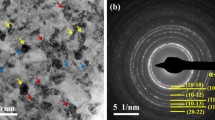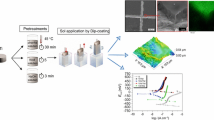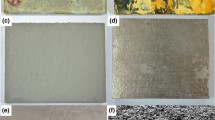Abstract
In this research, TiAl3 layers with different thicknesses were deposited on a titanium sheet by immersion of titanium in molten aluminum for different times. The oxidation behavior of the coated titanium at 850 °C was investigated and the comparison of the results was made with the oxidation behavior of the uncoated titanium sheet. The results showed that the produced TiAl3 layer could protect the titanium substrate against the oxidation if it contains an appropriate quality and morphology, otherwise not only it cannot withstand the oxidation, but also it accelerates the oxidation process of the titanium substrate. The protection mechanisms of the layers were probed into, performing the XRD analysis. It was found that the TiAl3 layer morphology affects oxidation mechanism and oxidation products.
Similar content being viewed by others
Avoid common mistakes on your manuscript.
1 Introduction
Titanium aluminides are used because of the high elastic modulus, low density and good mechanical properties in high temperatures [1]. These materials have good thermal resistance (two times more than nickel super alloys). In addition, heating problems that occur above 600 °C in titanium alloys do not occur in titanium aluminides [2, 3]. Three major combinations in the aluminum-titanium binary system include: Ti3Al, TiAl and TiAl3. Among these three, TiAl3 is of higher significance, because of the lightness and the resistance it has against the oxidation at high temperatures. Since TiAl3 is brittle in low temperatures, it seems that the formation of TiAl3 as a coating, using the powder metallurgy or in the solid state, does not have enough quality to protect the substrate [4]. But with the immersion of the titanium sheet in the molten aluminum, the TiAl3 layer is smooth and contains high quality [5]. Therefore, it could be protective against the oxidation.
Kofstad [6] studied the oxidation behavior of the pure titanium and showed that the temperature plays a significant role in the oxidation process. It also arrived at the conclusion that, up to 400 °C, the growth of the titanium oxide layer is logarithmic, and as the temperature increases to 600 °C, the process approaches the parabolic state. When the temperature ranges from 700 to 1300 °C, the oxidation rate decreases and approaches a linear trend. They detected the TiO2 as the only titanium oxide phase.
Gemelli et al. [7] have also observed the TiO2 phase as the titanium oxidation product at 800 °C. Ottaviani et al. [8] have demonstrated the oxidation behavior of the pure titanium based on Fig. 1. As shown in this figure, different oxidation behaviors of titanium are introduced in different temperature intervals. Some investigations have also been conducted on the oxidation behavior of the titanium aluminide compounds. Takayama [9] has pointed out the effect of titanium aluminide compounds on the titanium oxidation resistance. Lavrenko et al. [10] have similarly reported that the formation of the Al2TiO5 phase is why the oxidation resistance of the titanium aluminides increases at high temperatures. TiAl3 is also considered as a better option to withstand the oxidation compared to the other titanium aluminides at the temperatures higher than 1000 °C. Results offered by Mencer [11] suggest that the temperature, oxygen pressure and iron aluminide composition affect the oxidation behavior. Reddy et al. [12] have experimentally studied the oxidation behavior of TiAl3 at temperatures ranging from 900 to 1000 °C. In this study, it has been reported that the TiAl3 oxidation rate is high at the outset, but after a long period of time it tends to be steady and then again the oxidation rate increases, which then begins to form Al2O3. Consequently, by increasing the thickness, some cracks are formed in the layer, the formation of which facilitates the oxidation process.
a Schematic of the titanium oxidation rate, b Types of rate changes [8]
The innovation of the present study is the investigation of the effect of TiAl3 coating thickness and morphology formed using the immersion of titanium sheets in molten aluminum, on titanium oxidation behavior.
2 Materials and Methods
Pure titanium sheet (Table 1) and Aluminum ingot (purity of 99.6%) were utilized in this study.
The samples were prepared with 1 × 1 cm dimensions from the titanium sheet (thickness of 2 mm). The molten aluminum was also prepared using an aluminum ingot in an alumina crucible at the temperature of 750 °C. Titanium samples were immersed in the molten aluminum after a surface preparation and was removed from the molten aluminum after different periods of time for various samples including: 2, 5, 10 and 30 min and 1 h. Prior to the putting the titanium sheet into the melt, the surface oxide was removed using an agitator to prevent the sheet to contact with the alumina layer on the top of the molten aluminum, (Fig. 2).
After removing the titanium samples, the frozen aluminum was removed from the surface using the grounding by a SiC paper. According to the final dimensions, the similar samples were cut from the titanium sheet. Both the coated and uncoated titanium samples were separately weighed and placed in a tube furnace at the temperature of 850 °C in the air atmosphere. Every 5 h, a titanium sample and coated samples were removed from the furnace and cooled in the air. The removed samples were weighted and some of them were analyzed performing the XRD analysis.
3 Results and Discussion
As mentioned before, as for the first step, the optimum thickness of the intermetallic layer was determined by the immersion of a titanium sheet in the molten aluminum at 750 °C for 2, 5, 10, 30 min and 1 h. The previous published research [5] showed that intermetallic layer growth occurred gradually at the initial times. Increase in thickness leads to cracking and disruption of the TiAl3 layer at longer periods of time.
Since the purpose of this research was to produce a dense and protective intermetallic layer, the temperature of 750 °C and intervals of 2, 5, 10, 30 min and 1 h were selected. Figure 3 illustrates the SEM images from the titanium samples immerged in the molten aluminum at 750 °C for 2, 5, 10, 30 min and 1 h. The EDX analysis was performed to determine the composition of the titanium aluminide layer. It confirmed the fact that the TiAl3 compound is the dominant phase in the surface layer.
As evident in Fig. 3, in a shorter time (2 min) no reaction occurred between titanium and molten aluminum but a dense TiAl3 layer was produced after 5 min. As time passes by, disruption begins and intensifies the intermettalic layer as a result of the different molar volumes of titanium and TiAl3 (4.3 and 3.3 g/cm3 respectively). This may lead to tensile stresses in the Ti-TiAl3 interface and consequently to TiAl3 layer disruption.
The gain weights versus time for both the coated and the uncoated titanium samples are demonstrated in Fig. 4. Considering this Figure, the sample immersed for 5 min in the molten aluminum has the most protective ability. With regard to Fig. 5, the XRD results and Fig. 6, the optical micrographs of the samples oxidized for 130 h at 850 °C, the proposed mechanism is shown in Fig. 7.
An increasing trend is observed after around 65 h in the oxidation curve of the 5 min coated titanium (Fig. 4) which can be attributed to the thickening of the Al2O3 layer. This results in the formation of some micro cracks in the surface Al2O3 layer which facilitates the passage of the oxygen. As a new layer of Al2O3 is formed, the oxidation process slows down again. The XRD results confirm the mentioned mechanism (Fig. 5).
The extent of oxidation of the coated titanium samples increases by the time of the immersion (Fig. 4). In the sample of 10 min coated titanium, the oxidation process increases more than the extent which was observed previously. Since the outer layer is crooked, surface cracks occur sooner and easily. Producing a new protective alumina layer causes the oxidation process to approach the stable state (Fig. 7) which follows the same process as the previous sample. In the oxidation product of the 10 min coated sample, only alumina is detectable and no titanium oxides are observed in the XRD results (Fig. 5), same as the 5 min coated sample. So up to this thickness, the TiAl3 layer can protect the substrate against the oxidation. But in the XRD result of the oxidation of the 30 min coated titanium, TiO2 is also detected (Fig. 5), the reason for which is the presence of slots between the surface aluminide particles. The previously mentioned slots causes the crack spread to accelerate by increasing the thickness of the alumina. This causes the substrate titanium to be oxidized and hence the TiO2 is formed. This phenomenon occurs in the 1 h coated titanium so intensely to the extent that the oxidation of the 1 h coated titanium exceeds the oxidation of the uncoated titanium as time passes by. For the uncoated titanium sample, the oxidation speed is faster in the initial times and reach a plateau in the longer runs (Fig. 4) by formation of TiO2 (Fig. 5).
The thermodynamic data is also used to predict the oxidation behavior of titanium. To achieve this goal in the first step, titanium oxidation is considered. The titanium is assumed to be the only material and the oxygen is added step by step. The equilibrium phases are investigated by HSC software [13]. Figure 8 shows the equilibrium phases of the titanium oxidation process. As shown in this Figure, thermodynamically, the oxidation of titanium initially leads to the formation of TiO. By increasing the amount of oxygen, TiO starts to transform to the Ti2O3 phase. As the oxidation process continues, the formation of Ti3O5 and TiO2 phases occur.
In the present study except for TiO2, no other titanium sub-oxides formed. This also confirmed by other researchers. Gemelli et al. [7] have detected the TiO2 phase as the titanium oxidation product at 800 °C. Kofstad [6] has also reported that the titanium oxide growth below 1300 °C leads to the formation of TiO2. The reason for this can be the high pressure of oxygen in the air atmosphere.
The thermodynamic studies were also conducted on the oxidation of a system contained aluminum and titanium. The purpose of this section was to predict the oxidation behavior of TiAl3. It should be made clear which element in the TiAl3 layer (Ti or Al) would tend to produce an oxide and what type of oxides can form. To achieve the purpose, it was assumed that the primary ratio of 1:3 of titanium and aluminum (based on the TiAl3 chemical formula) was present in the system. The oxygen was added and its molar ratio increased at each step. The result of thermodynamic perdition is presented in Fig. 9. As shown in this Figure, while the aluminum presents, because of the Al2O3 stability, no titanium oxide can appear. This is the main reason that the TiAl3 phase is protective against the oxidation. But in practice, some of the factors, such as the titanium aluminide morphology lead to the disruption of the titanium aluminide layer and suppress its protective role. In the samples immersed for 30 min and 1 h due to an increase in the thickness of the TiAl3 layer, as well as its specific morphology, after creating the alumina as the result of TiAl3 oxidation, a sudden fracture occurs in the layer resulting in cracking the intermetallic layer and the substrate so that Ti substrate exposed directly to the air. As a result, this part of titanium oxidized the same as uncoated titanium.
4 Conclusion
The effect of TiAl3 coating thickness and morphology formed using the immersion of titanium sheets in molten aluminum, on titanium oxidation behavior was investigated. The oxidation behavior of the coated titanium at 850 °C was studied and the comparison of the results was made with the oxidation behavior of the uncoated titanium sheet. The mechanism of oxidation also interpreted for uncoated titanium sheet and the coated titanium samples (with the 5, 10, 30 min and 1 h immersing time). It was found that the produced TiAl3 layer could protect the titanium substrate against the oxidation if it contains an appropriate quality, thickness and morphology, otherwise not only it cannot withstand the oxidation, but also it accelerates the oxidation process of the titanium substrate.
References
S. Djanarthany, J.C. Viala, J. Bouix, Mater. Chem. Phys. 72, 301–319 (2001)
D.M. Dimiduk, Mater. Sci. Eng., A 26, 3281–3288 (1999)
E.A. Loria, Intermetallics 8, 1339–1345 (2000)
C. Leyens, Oxidation and Protection of Titanium Alloys and Titanium Aluminides, Titanium and Titanium Alloys (Wiley-VCH Verlag GmbH & Co. KGaA, Weinheim, 2005), pp. 187–230
R. Khoshhal, M. Soltanieh, M. Mirjalili, Iran. J. Mater. Sci. Eng. 7, 24–31 (2010)
P. Kofstad, J. Less Common Metals 12, 449–464 (1967)
E. Gemelli, N.H.A. Camargo, Matéria (Rio de Janeiro) 12, 525–531 (2007)
G. Ottaviani, F. Nava, G. Queirolo, G. Iannuzzi, G. de Santi, K.N. Tu, Thin Solid Films 146, 201–207 (1987)
I. Takayama, Nippon steel technical report, 1994
V.A. Lavrenko, A.D. Panasyuk, S.A. Firstov, Powder Metall. Met. Ceram. 42, 291–296 (2003)
D.E. Mencer, T.R. Hess, T. Mebrahtu, D.L. Cocke, D.G. Naugle, J. Vac. Sci. Technol. A Vac. Surf. Films 9, 1610–1615 (1991)
R.G. Reddy, X. Wen, I.C.I. Okafor, Metall. Mater. Trans. A 31, 3023–3028 (2000)
Outokumpu Research, Finland, 2002
Author information
Authors and Affiliations
Corresponding author
Rights and permissions
About this article
Cite this article
Khoshhal, R. Effect of TiAl3 Coating Thickness and Morphology, Formed Using the Immersion of Titanium Sheets in Molten Aluminum, on Titanium Oxidation Behavior. Met. Mater. Int. 25, 449–455 (2019). https://doi.org/10.1007/s12540-018-0183-7
Received:
Accepted:
Published:
Issue Date:
DOI: https://doi.org/10.1007/s12540-018-0183-7













